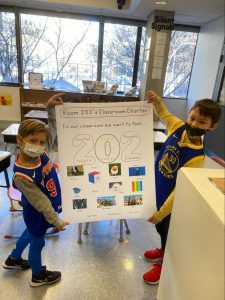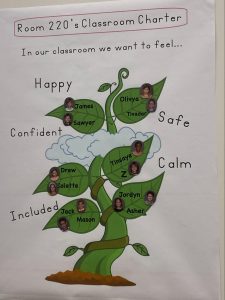By Dr. Lauren Levenson. This article originally appeared in the Summer 2022 Gaynor Gazette.
Since RULER’s implementation at Gaynor, we have been finding creative ways to incorporate anchor tools into the classroom in developmentally appropriate and unique ways. Developed by the Center for Emotional Intelligence at Yale, RULER is a social-emotional program that helps students learn how to cope with their feelings, make decisions, and get along with others. Anchor tools are designed to enhance the emotional intelligence of the school community and include things such as the Mood Meter, Meta-Moments, and Charters.
classroom in developmentally appropriate and unique ways. Developed by the Center for Emotional Intelligence at Yale, RULER is a social-emotional program that helps students learn how to cope with their feelings, make decisions, and get along with others. Anchor tools are designed to enhance the emotional intelligence of the school community and include things such as the Mood Meter, Meta-Moments, and Charters.
During Social Emotional Learning lessons that I taught to the Pink through Yellow Clusters, students spent the first semester thinking about what it means to be a community member and how a positive emotional climate in the classroom can support learning. Each class created a classroom Charter that uniquely represented the community, emotions, and responsibilities students and teachers wanted to establish together. The Charter is a particularly important tool as it builds and sustains positive emotional climates by creating agreed-upon norms for how people want to feel, as well as how they can help each other to experience those feelings.
Creating a classroom Charter was differentiated for each class and cluster but ultimately aimed to answer two main questions:
1. How would we like to feel in school?
2. How will we help each other and ourselves to experience these feelings?
As the students all went through the process of identifying how they want to feel, they were then able to collectively reflect on the feeling words of their classmates, and work collaboratively by voting on which words ultimately represented how the students want to feel at school. The Charter creates a sense of community and ownership in how students want to feel and how they want their peers to feel, as they were fully involved in the creation from start to finish.
 For many students, creating a Charter was a time to practice voting, to work on collaboration, and to compromise. It also allowed students to practice problem solving, as they needed to remain flexible when deciding which words best represented how they wanted to feel at school.
For many students, creating a Charter was a time to practice voting, to work on collaboration, and to compromise. It also allowed students to practice problem solving, as they needed to remain flexible when deciding which words best represented how they wanted to feel at school.
Once students selected their feeling words, they brainstormed ways in which they could help each other to feel those emotions at school. While not all the ideas made it on the Charter, these conversations were critical in establishing the role of empathy, both in social relationships and at school.
Finally, our students had the opportunity to suggest designs for the Charter or submit their individual creations for their classmates to vote on. Students were encouraged to pick a design reflective of their classroom community and one that would bring them joy! We are extremely proud of our students who continue to grow and challenge themselves through SEL work every day.
